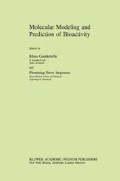Abstract
The precise function of the 5-HT receptors remains undefined, and progress toward this has been hampered by the lack of selective ligands.
Access this chapter
Tax calculation will be finalised at checkout
Purchases are for personal use only
Preview
Unable to display preview. Download preview PDF.
References
H. E. Hamm, The many faces of G protein signaling, J. Biol. Chem., 273: 669 (1988).
S. R. Sprang, G Protein mechanism: insights from structural analysis, Annu Rev. Biochem., 66: 639 (1997).
Data from Trends in Pharmacological Sciences: RECEPTOR & ION CHANNEL NOMENCLATURE SUPPLEMENT, (1998).
L. J. England, J. Imperial, R. Jacobsen, A. G. Craig, J. Gulyas, M. Akhtar, J. Rivier, D. Julius, B. M. Olivera, Inactivation of a serotonin-gated ion channel by a polypeptide toxin from marine snails, SCIENCE,281: 575 (1998) and enclosed references.
J. Hoflack, S. Trumpp-Kallmeyer, M. F. Hilbert, Molecular modelling of G-protein coupled receptors, in 3D QSAR in Drug Design. Theory methods and applications,H. Kubinyi, ed., ESCOM SciencePublishers, Leiden(1993).
P. Gaillard, P-A Carrupt, 13. Testa and P. Schambel, Binding of Arylpiperazines, (Aryloxy)propanolamines, and Tetrahydropyridylindoles to the 5-HT1A Receptor: contribution of the molecular lipophilicity potential to three-dimensional quantitative structure-activity relationship models, J. Med Chem.,39: 126 (1996) and enclosed references.
HASL (Hypothetical Active Site Lattice), Hypothesis Software, PO Box 237, Long Valley, NJ 07853. (email: hyposoft@cris.com; www.cris.com/~Hyposoft).
A. M. Doweyko, The Hypothetical Active Site Lattice. An approach to modelling active sites from data on inhibitor molecules, J. Med Chem., 31: 1396 (1988).
H. M. Chen, J. J. Zhou, G. R. Xie, PARM: A genetic evolved algorithm to predict bioactivity, J. Chem. Inf. Comput. Sci., 38: 243 (1998).
M. Modica, M. Santagati, F. Russo, L. Parotti, L. De Gioia, C. Selvaggini, M. Salmons and T. Mennini, [[(Arylpiperazinyl)alkyl]thio]thieno [2,3-d]pyrimidinone derivatives as high-affinity, selective 5-HTIA receptor ligands, J. Med. Chem., 40: 574 (1997).
SYBYL Molecular Modelling Software, Tripos Inc., 1699 S. Hanley Raod, Suite 303, St. Louis, MO 63144.
SPARTAN 5.03 Molecular Modelling Software, WavefunctionInc., 18401 Von Karman Avenue, Suite 370, Irvine, CA 92612.
R. D. Cramer, III, D. E. Patterson, J. D. Bunce, Comparative molecular field analysis (CoMFA).1. Effect of shape on binding of steroids to carrier proteins, J. Am. Chem. Soc., 110: 5959 (1988).
Author information
Authors and Affiliations
Editor information
Editors and Affiliations
Rights and permissions
Copyright information
© 2000 Springer Science+Business Media New York
About this chapter
Cite this chapter
Santagati, M. et al. (2000). 5-HT1A Receptors Mapping by Conformational Analysis (2D NOESY/MM) and “Three Way Modelling” (HASL, CoMFA, PARM). In: Gundertofte, K., Jørgensen, F.S. (eds) Molecular Modeling and Prediction of Bioactivity. Springer, Boston, MA. https://doi.org/10.1007/978-1-4615-4141-7_21
Download citation
DOI: https://doi.org/10.1007/978-1-4615-4141-7_21
Publisher Name: Springer, Boston, MA
Print ISBN: 978-1-4613-6857-1
Online ISBN: 978-1-4615-4141-7
eBook Packages: Springer Book Archive

